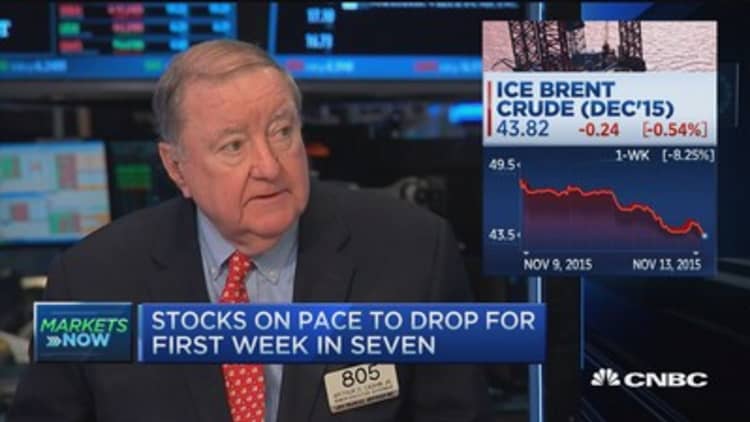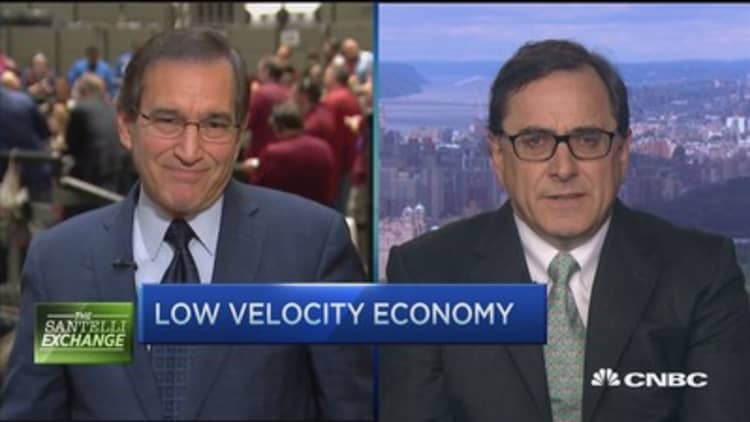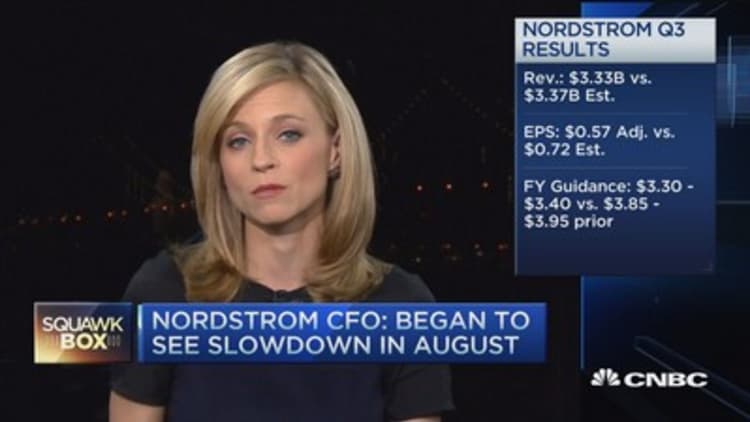



U.S. stocks closed more than 1 percent lower Friday, pressured by a continued decline in oil prices and soft reports on the health of the consumer. (Tweet This)
The major averages ended the week down more than 3.5 percent, their worst since the week ended August 21 and breaking a 6-week win streak.
"I think what the market is worried about is declining commodity prices in the face of a rate hike," said Robert Pavlik, chief market strategist at Boston Private Wealth. He noted that low oil prices and weaker-than-expected retail sales added to concerns of economic slowdown.
The Dow Jones industrial average closed down about 200 points, with Nike and Home Depot the greatest weights on the index.
The S&P 500 fell through its 100-day moving average of 2,034, dragged down by a more than 2.5 percent decline in consumer discretionary and a 2 percent drop in information technology.
It's "another disappointing day from retail sales on the heels of Nordstrom having really disappointing sales," said JJ Kinahan, chief strategist at TD Ameritrade.
"The one thing I find interesting today again is crude, which looks like it could flirt again with $40. That will probably weigh on the market all day," he said.
Crude oil came off session lows to settle down $1.01, or 2.42 percent, at $40.74 a barrel.
Read MoreWhy the price of oil has got stock traders spooked
The Nasdaq composite underperformed as Apple lost nearly 3 percent to end below its 50-day moving average. The Nasdaq closed below the psychologically key level of 5,000 for the first time since Oct. 22 and traded below for for the first time in intraday trade since Oct. 23. The index is the only major average still positive year-to-date.
The iShares Nasdaq Biotechnology ETF (IBB) was one of the few advancers in Friday's session, ending up 1.1 percent. The ETF still lost 2 percent for the week.
The major indexes pared losses slightly in midday trade before holding lower.
"I think right now investors are really prone to being nervous. There's the specter of the Fed moving in December," said Thomas Lee of Fundstrat Global Advisors.
In a note Friday, Fundstrat downgraded consumer discretionary to neutral in favor of energy. Lee said rising wages would become a headwind for the sector an increasingly competitive retail environment.
October retail sales showed an increase of 0.1 percent, below expectations of a 0.3 percent rise. Retail sales excluding automobiles, gasoline, building materials and food services rose 0.2 percent after an upwardly revised 0.1 percent gain in September.
Nordstrom closed down nearly 15 percent, for its worst day since July 2000. The stock is down 32 percent year-to-date.
The retailer posted earnings after the close Thursday that missed estimates by 15 cents, on revenue that fell below analyst projections as well. The firm cut its 2015 sales and profit forecast, but unlike competitors who pointed to weather and inventory issues, Nordstrom did not specify a reason for the cut.
Before the opening bell, J.C. Penney posted a smaller-than-expected loss in quarterly earnings, on revenue that topped estimates. The company said earlier in the week that comparable-store sales grew by 6.4 percent, while analysts polled by FactSet expected a 5.7 percent increase.
The stock closed down nearly 15.4 percent, up 14.8 percent for the year so far.
"It's a bit surprising they're selling off as hard as they are. What you're seeing is investors recalibrating expectations for the segment," said Efraim Levy, equity analyst at S&P Capital IQ, which is positive on consumer discretionary. "A lot of company multiples have been rising to the higher end of the historical range."
"Now that you're seeing department stores and other retailers not performing so well, consumers are making purchases elsewhere," he said. "There's a revaluation going on in the sector."
Read MoreEarly movers: JCP, FIT, TYC, EPC, YELP, GME, WEN, TWC, LGF & more
"I think the biggest issue today both for the (consumer) companies and stocks is the inventory risk," said Ike Boruchow, managing director of retailing, department stores and specialty softlines at Wells Fargo.
The retail earnings follow mostly disappointing results from Macy's earlier in the week.
"I still think the opportunity within consumer discretionary is more nuanced than buying the sector at large," said Mark Luschini, chief investment strategist at Janney Montgomery Scott.
In another sign of little inflation, the producer price index for October fell 0.4 percent, after falling 0.5 percent the previous month.
The preliminary read on November consumer sentiment hit 93.1, topping expectations.
rose 0.3 percent, while sales were unchanged.
Read More Economy delivers another headache to the Fed
Cleveland Fed President Loretta Mester said Friday the time to hike U.S. interest rates is "quickly approaching" and repeated her longstanding belief that the economy can handle an initial rate hike.
Treasury yields edged lower, with the 10-year yield at 2.28 percent and the 2-year yield at 0.85 percent.
The U.S. dollar traded slightly higher against major world currencies, with the euro near $1.07 and the yen at 122.70 yen against the greenback.
A sharp decline in commodity prices pressured U.S. equities Thursday, and continued to weigh on Asian and European equities overnight. The STOXX Europe 600 ended 0.8 percent lower, while the Nikkei was off about half a percent and the Hang Seng closed down more than 2 percent.
On Thursday, the S&P 500 and Dow Jones industrial average closed below their 200-day moving average for the first time since Oct. 22.
Major U.S. Indexes
The Dow Jones industrial average closed down 202.83 points, or 1.16 percent, at 17,245.24, with Cisco the greatest laggard and DuPont leading advancers.
The blue chip index lost 3.71 percent for the week. Cisco was the worst decliner for the week, while DuPont and General Electric were the only gainers.
Read MoreCisco shares slide on guidance
The S&P 500 closed down 22.93 points, or 1.12 percent, at 2,023.04, with consumer discretionary leading nine sectors lower and materials the only advancer.
The index fell 3.63 percent for the week. Energy fell nearly 6 percent as the worst performer for the week, while utilities was the only sector to post gains for the week, up 0.3 percent.
The Nasdaq composite closed down 77.20 points, or 1.54 percent, at 4,927.88.
The Nasdaq lost 4.26 percent for the week.
The CBOE Volatility Index (VIX), widely considered the best gauge of fear in the market, topped 20 for the first time since Oct. 6.
The VIX rose nearly 41 percent for the week, its second-largest gain for the year, behind the week ended Aug. 21.
About three stocks declined for every two advancers on the New York Stock Exchange, with an exchange volume of 947 million and a composite volume of 4.2 billion in the close.
High-frequency trading accounted for 49 percent of November's daily trading volume of about 7.1 billion shares, according to TABB Group. During the peak levels of high-frequency trading in 2009, about 61 percent of 9.8 billion of average daily shares traded were executed by high-frequency traders.
Gold settled down 10 cents at $1,080.90.
— CNBC's Peter Schacknow and Reuters contributed to this report.






